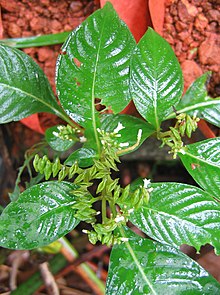Ophiorrhiza
Appearance
| Ophiorrhiza | |
|---|---|

| |
| Ophiorrhiza mungos | |
| Taksonomia | |
| Pagarian: | |
| (di nairanggo): | |
| (di nairanggo): | |
| (di nairanggo): | |
| Urnos: | |
| Pamilia: | |
| Henero: | Ophiorrhiza |
| Dagiti sebbangan | |
|
Agarup a 150,[1] see text | |
Ti Ophiorrhiza ket ti henero dagiti agsabsabong a mula iti pamilia ti kape (Rubiaceae). Dagiti sebbangan ti henero ket aglaon iti camptothecin, ti maysa nga alkaloid nga inus-usar iti panagaramid kadagiti ahente ti kemoterapia.[2][3]Adu kadagiti sebbangan ti Ophiorrhiza ket endemiko kadagiti naisangayan a lugar ti akinlaud a Ghats.
Dagiti sebbangan ket mairaman dagiti sumaganad:
- Ophiorrhiza acuminata[4]
- Ophiorrhiza blumeana[5]
- Ophiorrhiza bracteata[5]
- Ophiorrhiza cantoniensis
- Ophiorrhiza carinata
- Ophiorrhiza caudata[2]
- Ophiorrhiza dulongensis
- Ophiorrhiza filistipula
- Ophiorrhiza japonica
- Ophiorrhiza kuroiwai[6]
- Ophiorrhiza liukiuensis[4]
- Ophiorrhiza longiflora
- Ophiorrhiza lurida
- Ophiorrhiza major[5]
- Ophiorrhiza michelloides[7][8]
- Ophiorrhiza mungos
- Ophiorrhiza nutans
- Ophiorrhiza prostrata[1]
- Ophiorrhiza pumila[4][9]
- Ophiorrhiza rosea
- Ophiorrhiza rugosa
- Ophiorrhiza succirubra
Dagiti nagibasaran
[urnosen | urnosen ti taudan]- ^ a b Beegum, A. S., et al. (2007). Organogenesis from leaf and internode explants of Ophiorrhiza prostrata, an anticancer drug (camptothecin) producing plant. Electronic Journal of Biotechnology 10:1.
- ^ a b Joseph, G. and J. P. Joseph. Rediscovery of Ophiorrhiza caudata (Rubiaceae) from the Western Ghats of Kerala. Rheedia 19 45.
- ^ Viraporn, V., et al. (2010). Correlation of camptothecin-producing ability and phylogenetic relationship in the genus Ophiorrhiza. Planta Med. in pub.
- ^ a b c Sirikantaramas, S., et al. (2008). Mutations in topoisomerase I as a self-resistance mechanism coevolved with the production of the anticancer alkaloid camptothecin in plants. PNAS 105:18 6782.
- ^ a b c Arbain, D, et al. (1998). Unusual indole alkaloids from Ophiorrhiza blumeana Korth. J. Chem. Soc., Perkin Trans 1.
- ^ Asano, T., et al. (2004). Camptothecin production by in vitro cultures of Ophiorrhiza liukiuensis and O. kuroiwai. Plant Biotechnology 21:4 275.
- ^ Chu, F., et al. (2006). Taxonomic Status of Ophiorrhiza michelloides (Masam.) X. R. Lo (Rubiaceae) in Taiwan. Taiwania 51:2 143.
- ^ Nakamura, K., et al. (2006). Phylogenetic systematics of the monotypic genus Hayataella (Rubiaceae) endemic to Taiwan. Journal of Plant Research 119:657–661.
- ^ Nakamura, K., et al. (2006). Homostyly and autogamy in Ophiorrhiza pumila (Rubiaceae) in the Ryukyu Archipelago. Journal of Japanese Botany 81:113–120.
Dagiti akinruar a silpo
[urnosen | urnosen ti taudan]- Vascular Plants of Gaoligong Shan, Yunnan, China: Ophiorrhiza Naiyarkibo 2016-03-04 iti Wayback Machine
- Darwin, S. P. (1976). The Pacific species of Ophiorrhiza (Rubiaceae). Naiyarkibo 2016-03-04 iti Wayback Machine Lyonia 1:2.
